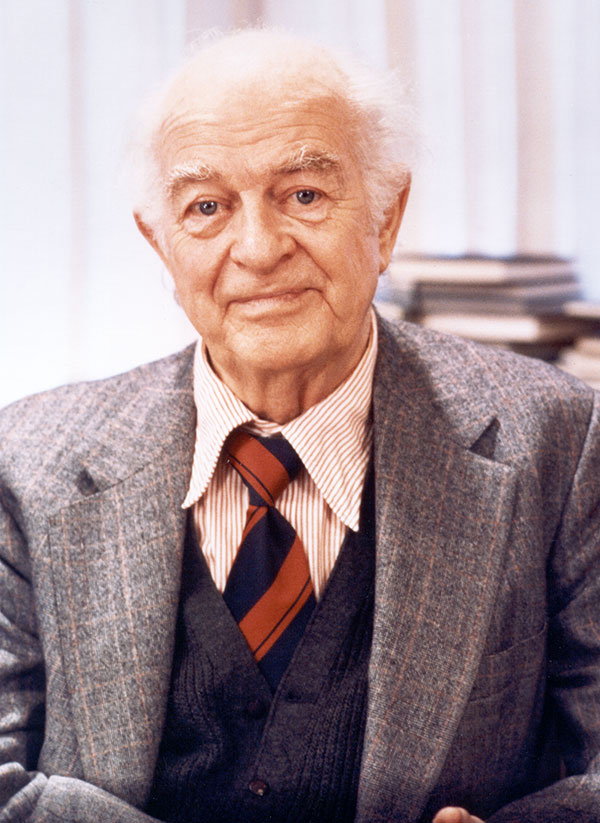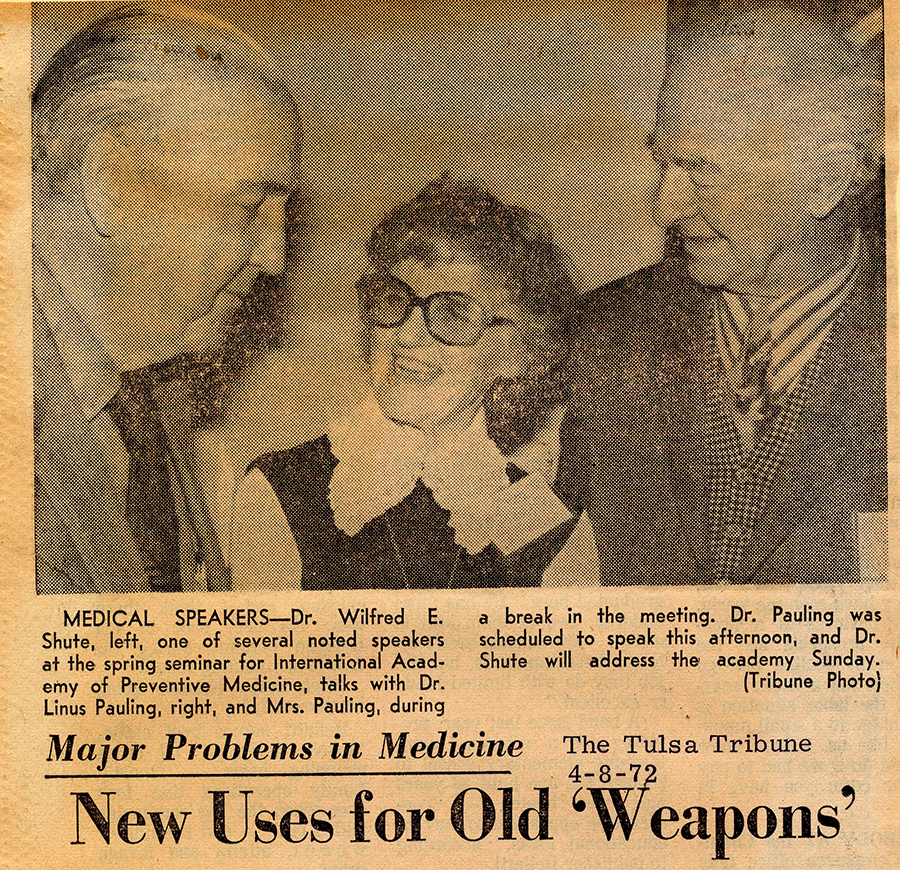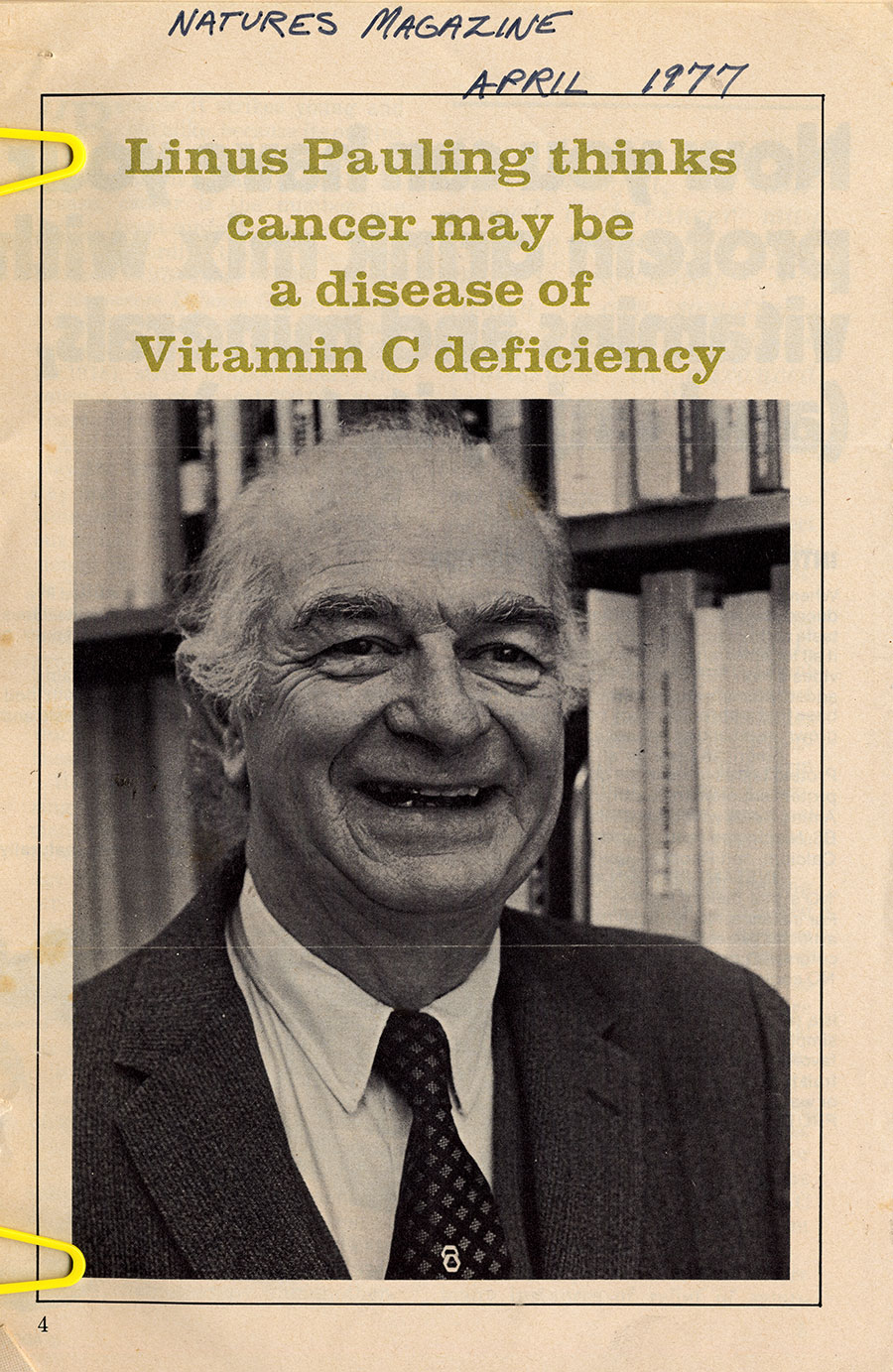[Part 9 of 9]
In 2018, a third edition of Ewan Cameron and Linus Pauling’s book, Cancer and Vitamin C, was published. Released nearly a quarter century after Pauling’s death, this edition marked the first time that someone other than Pauling or Cameron contributed to the volume. The second edition, which was published in 1993, included an updated preface and a few new indices, but the text itself remained entirely Cameron and Pauling’s. The 2018 edition also includes a new preface and a new index, but both were written by Stephen Lawson of the Linus Pauling Institute at Oregon State University. Lawson used the new additions to ably present recent scholarship connecting the efficacy of vitamin C to the treatment of cancer.
One bit of background that Lawson sought to clarify at the outset was the story of why vitamin C treatments for cancer had not been initially supported by outside research. As noted in our previous posts, Pauling and Cameron believed that external research corroborating their results would provide an effective avenue for convincing skeptics of the curative powers of vitamin C. The Mayo Clinic eventually agreed to conduct a study of this sort, but found that vitamin C did not improve cancer patients’ prognoses, and in some instances their outcomes were actually worse.
Even though Pauling and Cameron did not agree with the Mayo Clinic’s findings, they had a hard time making their case to the public about why the study was in error. But as described by Lawson in the 2018 preface, Pauling and Cameron recognized that the Mayo Clinic’s treatment protocols were different than their own in important ways. Specifically, Cameron and Pauling had always delivered vitamin C intravenously, whereas the Mayo Clinic researchers dosed their patients orally. At the time, Pauling and Cameron could not prove why this should make a difference, but they believed that it was a key reason why the Mayo Clinic did not get positive results. While science could not confidently address this scenario in 1979 – or even in 1993 at the time of the second edition – by 2018 researchers had developed a much clearer idea of the importance of intravenous application.
Beginning in 1999, a team of researchers began actively exploring the absorption of vitamin C and, in particular, whether or not there was a difference between oral and intravenous applications. As they conducted their work, the group discovered a previously unknown vitamin C transport molecule in the stomach, which helped to deliver ascorbic acid into the bloodstream. The team subsequently learned that there was an upper limit to how much vitamin C the transport molecules could carry. This effectively meant that no matter how much vitamin C a person ingested orally – vitamin C that would end up in the stomach – only a finite amount could actually be absorbed and utilized, due to the limited carrying capacity of the transport molecule. The exact amount of vitamin C that a transport molecule can carry is still being researched, with data to this point indicating that quantities may vary based on factors such as age.
In tandem with this discovery, researchers were also interested in understanding what happens when vitamin C enters the bloodstream, be it intravenously or through transport molecules in the stomach. As Lawson notes, studies found that one byproduct of high levels of vitamin C in the bloodstream (regardless of how it got there) is hydrogen peroxide. Hydrogen peroxide has the ability to fight cancer by altering its DNA, robbing its cells of ATP (the “muscle” of the cell), and fatally damaging its energy-producing mitochondria. When deployed at scale, this three-pronged attack might be presumed to fight cancer very effectively.
That said, hydrogen peroxide therapy has not been used with cancer patients, because there is no safe and effective way to deliver the substance into the bloodstream without damaging other healthy cells. While the connection between vitamin C dosing and internal hydrogen peroxide production is not well-understood, these preliminary findings suggest that high blood concentrations of vitamin C could create hydrogen peroxide in sufficient quantity as to be effective at neutralizing cancer cells.
Several other new areas of research were highlighted in the 2018 edition, including the connection between vitamin C and hypoxia inducing factor (HIF). Some cancer tumors grow so fast that blood vessels cannot be created quickly enough to deliver oxygen to the expanding mass. To compensate for this lack of blood vessels in these hypoxic (or low oxygen) environments, tumor cells induce HIF, which stimulate the growth of blood vessels within the tumor. This inducement of HIF allows fast-growing tumors to continue to propagate and wreak havoc, rather than succumbing to oxygen starvation. For reasons that remain unclear, when vitamin C is introduced into a fast-growing tumor it represses the activation of HIF, compelling the tumor to remain in its hypoxic state and eventually die.
Emerging research on the relationship between vitamin C and dehydroascorbic acid (DHA) is also included in the 2018 edition. DHA is an oxidation product of vitamin C, and when present has been shown to reduce the amount of colorectal cancer in the body.
A collection of sixteen relatively recent clinical trials are likewise surveyed in the book, all of which examined the outcomes of different kinds of cancer patients when given vitamin C in conjunction with other chemotherapeutics. All sixteen found that patients’ outcomes improved once they were given the vitamin C in concurrence with their chemotherapy treatment. Five other studies were conducted on cancer patients given vitamin C but not chemotherapy. Results of these trials were mixed but, as Lawson points out, the non-chemotherapy researchers were primarily interested in determining optimal doses of vitamin C and measuring how quickly patients depleted their vitamin C infusions. Many of the trials also found that patient outcomes improved.
As with the original text of the book, a collection of case studies were also discussed by Lawson. And though they serve mostly as anecdotal evidence, Lawson shows that significant improvements in patients’ health have been documented once they have been administered vitamin C treatment.
One of the biggest takeaways that a reader might glean from the 2018 edition is that, even though a significant amount of research has been conducted on the vitamin C and cancer connection, medical practitioners have been hesitant to deploy the treatment because the studies have seemed less than rigorous, or because other practitioners have found that it does not work with their patients. Lawson counters these sentiments by noting that most cancer research is novel and that only the most promising ideas go on to clinical trials. Further, because an optimum vitamin C dose has not yet been codified, doctors commonly administer vitamin C on an ad hoc basis. Worse still, doctors also sometimes administer the treatment as a “last ditch” effort after chemotherapy and all other treatments have failed. Pauling and Cameron demonstrated in their first edition that vitamin C needs to be administered continuously and before chemotherapy to be maximally effective. Clearly much remains to be done before the work that Pauling and Cameron started with their first edition can be called complete.
Filed under: Orthomolecular Medicine | Tagged: Ascorbic Acid, cancer, Ewan Cameron, hydrogen peroxide, Linus Pauling, Steve Lawson, vitamin C | 1 Comment »





















